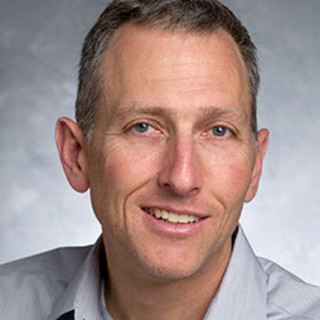
In high school, I was more comfortable in the pool playing water polo than studying in a classroom. I struggled in math and science, so it was no surprise that medical school was nowhere on my radar.
But the end of my liberal arts education and collegiate water polo playing days, however, I decided to challenge myself as a student. I took first-semester chemistry during the second semester of my senior year, and the spark was lit. Objective questions with demonstratively right or wrong answers were a better fit for me than the subjective political science essays I had been writing.
After graduation, I enrolled in a post-baccalaureate program to complete the premed science requirements. By day, I tackled three-dimensional carbon models. By night, I waited tables at a Chili's restaurant. Once I was accepted into medical school, any doubts about my path were silenced by my wide-eyed fascination with the physiology of the human body. What makes the heart contract in a rhythmic and synchronized fashion? How do the lungs extract oxygen from air and transport it into the bloodstream? What consequences arise when these organs are injured or fail? In answering these questions, the spark had turned into a flame.
I trained to become board-certified in both Internal Medicine and Pediatrics, eventually finding my true calling in the sub-specialty of Pulmonary and Critical Care. I was intrigued by the skill set of the intensivist: filtering hundreds of data points to make quick, high-stakes decisions, while needing a steady, proficient hand to perform procedures on the critically ill. The technical aspects of Critical Care drew me in and when I widened my focus beyond the treatment of diseased organs and abnormal lab values, I was able to connect and communicate more meaningfully with patients and their families. I had found my calling.
Physicians can dispense difficult information in an accurate, efficient, and sterile manner. Or they can engage with grieving families by sharing time, space, and vulnerability in an anxiety-filled room. Even when discussing a brutal diagnosis or grave prognosis, there are opportunities for intimate and authentic connections full of compassion, humility, and grace. My most meaningful memories are not white-knuckled life and death decisions. They are the quiet moments spent with patients and families, sharing their hopes, grief, and fears.
After 13 years in practice, I should be in the sweet spot of medicine: not too far from training to be out of step with the best practices in my specialty, but with plenty of experience and wisdom to offer in the care of my patients. I should be moving into leadership positions left open by retiring senior physicians and mentoring the next generation of wide-eyed future medical doctors. Instead, a year ago I cut back to part-time. Like many others in my profession, I am struggling to find the fuel to keep my flame bright.
Social media is packed with essays listing the "top ten reasons for burnout" or "five traits of happy doctors." Position papers from medical societies and leading journals detail ideas for its prevention and academic centers are forming committees to promote physician wellness. Throughout this cacophony, if you listen closely, there is a common chord formed by the many disparate notes.
Physicians dedicate and sacrifice their twenties and early thirties developing a unique vision of how they will bring their experience, knowledge, and compassion to their patients. Although that rarely translates perfectly in the real world, for many doctors the gap between the vision of what could be and what is has become a chasm so wide that it feels impossible to bridge. The doctors we aspire to be become the exception, rather than the rule.
After 12 years of practicing medicine, the divide between my ideal day and my reality was measurably fractured. Shifting gears between critically ill patients in the ICU with impromptu and emergent family meetings was emotionally exhausting. Ongoing trends to staff leaner ICUs stretched care teams too thin to care for the higher volume and acuity of the ICU population. Today's shorter hospital stays generate outpatients with active medical problems and unresolved social issues for which my office is ill equipped. My thirty-minute lunch break morphed into an hour of phone calls and paperwork, with time spent battling insurance companies to authorize treatments and prescriptions. Electronic medical records (EMRs) that can be accessed from my laptop destroyed the barriers that once kept me from bringing work home. Four years of a frivolous lawsuit consumed my free time. I spent hours reading depositions and reviewing old charts, only to be dropped the day before taking the stand. Through it all, I struggled to prioritize the growing complexity of my family.
My ability to maintain the status quo crumbled. Multiple rounds of snoozing replaced early morning exercise. Interactions with my partners felt less collegial. Evaluations from medical students were no longer filled with high marks and positive comments, and eventually nurses and new residents stopped looking forward to my time on service. Worst of all, morning rounds in the ICU became technical and checklist oriented, instead of patient centered, as my capacity to recognize opportunities for deeper connections with patients and families deteriorated.
Naively, I clung to the idea that simple, transient problems were to blame: maybe it was fatigue, the terrible stress of the lawsuit, a crazy flu season, or being short staffed. If I could just push through to my vacation week, I could recharge. I wanted there to be a reason. A fixable external problem. But ultimately, I had to look at myself. I needed to make a change.
I am lucky that the other physicians in my practice are friends as well as business partners. They were genuinely concerned about the changes in my behavior. But they were also frustrated because my situation negatively impacted their work environment. Ultimately, after 12 years, I gave up my partnership and cut back to 23 weeks a year. I take the same amount of call and weekend coverage as the rest of my group, but now have 29 weeks away from the hospital instead of six. While we are still friends, my choices caused some challenges within the practice. I upset the balance of our group dynamic that had been based on an equally shared workload. In decreasing my own burden, I obligatorily increased their work.
Initially, my patients were confused, worried I was abandoning them. A few transitioned to other doctors in my group. But most have been surprisingly enthusiastic and supportive of my decision. During visits, they ask what I have been doing with my time, if I have written anything new, and how my family is doing.
My children, ages 17 and 20, enjoy their dad being more physically and emotionally present. As a 47-year-old, I now have the unique opportunity to connect with them in new ways. I am a fellow student, heading back to school to earn a master's degree at Johns Hopkins Bloomberg School of Public Health. My son and I play on the same master's water polo team and I am coaching at my daughter's high school. She likes having me there, but would prefer her friends not know what her dad looks like wearing a speedo.
My wife had a front row seat with a clear view as the intensity, passion, and joy I once brought to work slowly eroded away. She encouraged me to make big changes, despite the impact they would have on our family's financial security and the uncertainty they would inject into our lives. Paradoxically, she feels enormous guilt about not earning a paycheck since she stopped teaching twenty years ago, but is unwavering in her support of my choices to coach the high school water polo team, write for my blog, train for triathlons and go back to school. She has allowed me to pursue other sparks in my life.
As for myself, when I look back on this past year, it is obvious how much a change was needed. At the hospital, I am no longer disappointed in my rounds and am again connecting with patients, families, residents, and students. I have regained the sense of satisfaction and purpose that I had lost. My weeks away from the ICU allow me to pursue my interests in writing and coaching, as well as being more present for my family. What started as a leap of faith onto an unfamiliar and undefined path has evolved. I am no longer simply taking a tentative step away from medicine to create much needed physical and emotional space. I am now striding towards a future that gains clarity with each new day. I know I am getting closer to that ideal day of mine. And I am comfortable knowing that many of them will not involve having a stethoscope around my neck.
Jeremy Topin, MD is a Pulmonary and Critical Care physician in Chicago. He writes about end-of-life issues in the ICU, physician burnout and work/life balance. He blogs at www.jtopinmd.com and tweets @jtopinmd. Dr. Topin is a 2018–19 Doximity Author.





